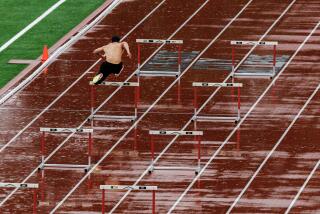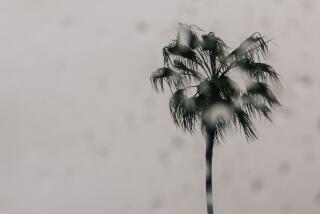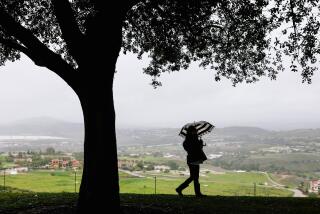Wet Weather Blankets Region
Relentless rain in Northern and Central California began to take its destructive toll Tuesday, causing levee breaches, mudslides and endless traffic jams.
The storm blanketed the state, pelting Los Angeles with unusually steady, driving rain that snarled traffic, drenched fragile hillsides and buckled the roof of a Rite Aid in Koreatown as customers scrambled to safety.
Merced in Central California was the hardest hit, as about 160 residents were evacuated from homes and four trailer parks after a portion of a levee in a flood-control canal crumbled.
And in Stanislaus County, emergency officials dispatched boats and swift-water rescue teams to the eastern part of the county after rising water stranded five people in their homes.
In Southern California, a day of terrible commutes began with a string of accidents before dawn.
One of the first and worst tie-ups happened just before 3 a.m. when a truck jackknifed on the eastbound 101 Freeway in the Chesebro Canyon area, dumping 80 gallons of fuel, California Highway Patrol officials said.
Numerous accidents followed throughout the day, slowing freeways to a standstill: Eight tow trucks were required to clear the road after a 10-car chain-reaction crash on southbound Antelope Valley Freeway in Santa Clarita at midmorning.
An evening collision between a pickup and a big rig in the southbound truck lanes of the Antelope Valley Freeway at Interstate 5 trapped three people.
They were eventually rescued and transported to hospitals.
California Highway Patrol Officer Richard Kimball said that throughout the L.A. area, the accident rate was about double that of a typical weekday. Nearly 470 collisions had occurred on county highways by late afternoon, compared with 231 for the previous Tuesday, when roadways were dry, he said.
Elsewhere in the region, the collapse of a portion of the roof at a Rite Aid drugstore on Vermont Avenue south of 3rd Street shortly after 4 p.m. sent about a dozen customers and store employees racing for the exits, said Los Angeles Fire Department spokesman Brian Humphrey.
A 66-year-old woman, who was knocked down in the crowd, was transported to Good Samaritan Hospital, where she was in good condition, he said.
Firefighters said the weight of standing water appeared to have caused a 30-foot-by-30-foot section of the roof to give way, sending debris and water cascading onto the store’s floor. The mishap also ruptured a water pipe, adding to the mess, Humphrey said.
A short time later, firefighters rescued a boy from a bridge abutment in the flood-swollen Bull Creek channel west of Van Nuys Airport.
A passerby who saw the boy clinging to the abutment called 911, Humphrey said. Members of the Fire Department’s swift-water rescue team lowered rescuers to the boy, gave him a helmet and life preserver, then lifted him to the bridge, where he was transferred to an ambulance.
Rescuers described him as in his early teens and “cold and wet,” Humphrey said.
The San Luis Obispo area felt the brunt of the storm, with more than 4 inches of rain falling in the foothills and mountains. Downtown Los Angeles, in contrast, had only about half an inch of rainfall by midafternoon Tuesday.
The storm system was turning counterclockwise, meaning that the rain was being brought up from the south, said meteorologist Jamie Smith of the National Weather Service.
In Southern California, warmer weather meant that snowfall stayed above the 8,000-foot level.
But farther north, in Mammoth Mountain Ski Area in the eastern Sierra, officials announced Tuesday that a new seasonal snowfall record had been set. A total of 619 inches had fallen this winter, they said -- including 50 inches since Saturday.
Elsewhere in Northern California, the rivers that are usually the most flood-prone were not causing any problems Tuesday, authorities said.
But the persistent rains have led to saturated soils, sending county and state road crews scrambling to clear a multitude of minor rock and mudslides from roads.
“You know the California hills,” said Napa County Emergency Services manager Neal O’Haire. “That bedrock with a clay layer -- once water gets in there, it becomes like grease and the trees start slumping.”
South of San Francisco on picturesque Highway 1, a two-mile stretch known as Devil’s Slide remained closed Tuesday, two days after the roadway first became unstable. Boulders fell onto the highway as two “slipouts” widened below the roadway, said Caltrans spokeswoman Lauren Wonder. Caltrans is building a tunnel to bypass the problematic stretch of highway, she said, but for now, “we’re still closed indefinitely.”
Meteorologists were predicting more rain for a while.
“It looks like kind of a broken record here, with more showers and isolated thunderstorms in the mix,” said National Weather Service meteorologist Rick Canepa. That could spell more problems like Tuesday’s. “We’re really expecting the slides to continue,” said CHP Officer Grant Boles of the Santa Cruz district. “And with that, trees and power lines” will come down.
“It’s been raining for about a week steady,” he said. “It’s just become saturated, and something’s gotta give.”
Times staff writer Jill Leovy and the Associated Press contributed to this report.
More to Read
Sign up for Essential California
The most important California stories and recommendations in your inbox every morning.
You may occasionally receive promotional content from the Los Angeles Times.










